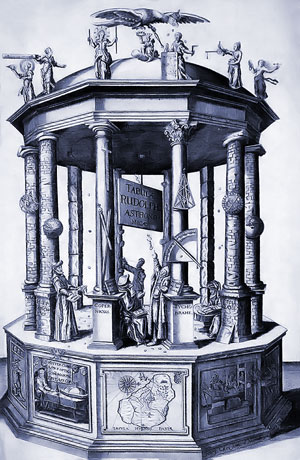
Cover of Johannes Kepler’s Rudolphine Tables
What is Mathematics
Even though everyone learns mathematics at school, it is difficult to define exactly what mathematics is. Clearly numbers, shapes and equations form part of it, but only a small part compared to the vast space of mathematical concepts and ideas. The best way to understand what mathematics is and what mathematicians work on – is to do mathematics.
One idea that appears everywhere in mathematics is abstraction. Instead of thinking about particular numbers, shapes, equations or any other objects, mathematicians tend to think about their underlying structures and patterns. This means that the results, called Theorems, are more general and provide deeper insight.
Another fundamental idea in mathematics is Proof. Mathematicians can’t just say that an idea is true, or test it in a few cases. They need a rigorous and watertight argument to deduce that it is always true. Maybe this makes mathematics more difficult than other sciences, but it also means that mathematicians can obtain absolute and definitive knowledge – which is impossible in any other discipline.
Despite being so abstract and theoretical, mathematics has countless applications in every possible aspect of life. Without mathematics our civilisation would be little more advanced than the ancient Egyptians: we wouldn’t have governments funded by a tax system, no phones, no television, no computers, no internet and no satellite navigation. The cultural value and the monetary economic value of mathematics are too large to measure.
Mathematics is also the language of the universe, from the electrochemical signals in our brain to the equations of General Relativity which govern the motion of stars and galaxies everywhere in the universe. It is one of humanity’s most noble endeavours to understand the universe we live in, and that would not be possible without mathematics.

Cover of Johannes Kepler’s Rudolphine Tables
What is Mathematics
Even though everyone learns mathematics at school, it is difficult to define exactly what mathematics is. Clearly numbers, shapes and equations form part of it, but only a small part compared to the vast space of mathematical concepts and ideas. The best way to understand what mathematics is and what mathematicians work on – is to do mathematics.
One idea that appears everywhere in mathematics is abstraction. Instead of thinking about particular numbers, shapes, equations or any other objects, mathematicians tend to think about their underlying structures and patterns. This means that the results, called Theorems, are more general and provide deeper insight.
Another fundamental idea in mathematics is Proof. Mathematicians can’t just say that an idea is true, or test it in a few cases. They need a rigorous and watertight argument to deduce that it is always true. Maybe this makes mathematics more difficult than other sciences, but it also means that mathematicians can obtain absolute and definitive knowledge – which is impossible in any other discipline.
Despite being so abstract and theoretical, mathematics has countless applications in every possible aspect of life. Without mathematics our civilisation would be little more advanced than the ancient Egyptians: we wouldn’t have governments funded by a tax system, no phones, no television, no computers, no internet and no satellite navigation. The cultural value and the monetary economic value of mathematics are too large to measure.
Mathematics is also the language of the universe, from the electrochemical signals in our brain to the equations of General Relativity which govern the motion of stars and galaxies everywhere in the universe. It is one of humanity’s most noble endeavours to understand the universe we live in, and that would not be possible without mathematics.

Cover of Johannes Kepler’s Rudolphine Tables
What is Mathematics
Even though everyone learns mathematics at school, it is difficult to define exactly what mathematics is. Clearly numbers, shapes and equations form part of it, but only a small part compared to the vast space of mathematical concepts and ideas. The best way to understand what mathematics is and what mathematicians work on – is to do mathematics.
One idea that appears everywhere in mathematics is abstraction. Instead of thinking about particular numbers, shapes, equations or any other objects, mathematicians tend to think about their underlying structures and patterns. This means that the results, called Theorems, are more general and provide deeper insight.
Another fundamental idea in mathematics is Proof. Mathematicians can’t just say that an idea is true, or test it in a few cases. They need a rigorous and watertight argument to deduce that it is always true. Maybe this makes mathematics more difficult than other sciences, but it also means that mathematicians can obtain absolute and definitive knowledge – which is impossible in any other discipline.
Despite being so abstract and theoretical, mathematics has countless applications in every possible aspect of life. Without mathematics our civilisation would be little more advanced than the ancient Egyptians: we wouldn’t have governments funded by a tax system, no phones, no television, no computers, no internet and no satellite navigation. The cultural value and the monetary economic value of mathematics are too large to measure.
Mathematics is also the language of the universe, from the electrochemical signals in our brain to the equations of General Relativity which govern the motion of stars and galaxies everywhere in the universe. It is one of humanity’s most noble endeavours to understand the universe we live in, and that would not be possible without mathematics.



























